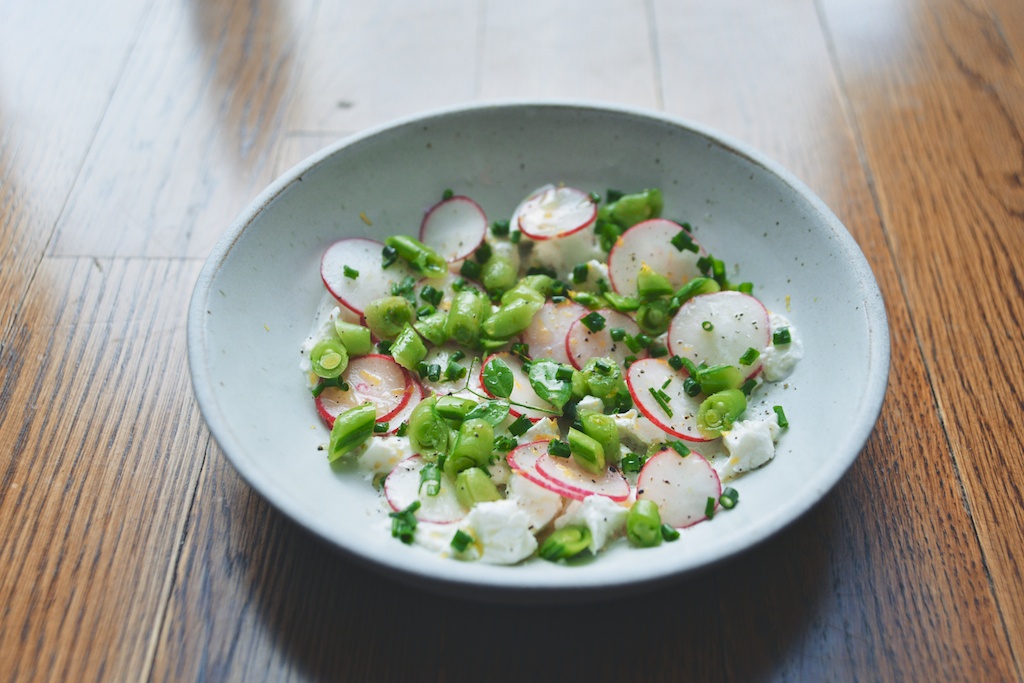I wake up abruptly, for no reason at all, in a white bed on Rue Cambon. The Frenchman is asleep, one arm thrown over his head like backstroke. He’ll have been out until small hours, drinking beers on the Canal St. Martin with friends. The room is small, all white, all teeth, except for a stained mirror occupying one wall. A single window runs to the ceiling: beyond gauze white curtains, a gray window box, a spray of fuchsia geraniums, and beyond that, the pearl light of an overcast summer day.
I brush my teeth to an episode of Downton Abbey I’ve seen several times already and then set out into the drizzling city. My first stop is G. Detou (the French love wordplay: “j’ai de tout” means “I have all”) where I sometimes buy fifty bean pouches of vanilla for a song, but today a massive bag of quality cocoa powder. I skirt along the edge of Les Halles. Paris is a city of settled beauty, but I love it for the tiny details, so easy to overlook: the almost hidden covered passages containing multitudes, the throwback, neon green detective’s sign just before the Louvre.
I take myself to Fish for lunch and sit at the bar and order Sancerre. I’ll have the white bean velouté, thin and earthy with whisker slicks of olive oil and sourdough croutons half submerged like sunken ships. I’ll eat juicy sole over tangles of purple cabbage, zucchini ribbons, fennel fronds, chervil, capers. It’s really raining now, so I order the darkest espresso there ever was and drop in a craggy raw sugar cube that I break up with a miniature, heated spoon. I read my book. The rain subsides.
The book is almost finished, and I’m downright heartbroken about, do you know what I mean? I walk to Shakespeare and Co. for a new one and there’s a line out the door; a tall, blonde, American actress is also buying books. I need some peace. I wind my way into the 3eme, so many turning, narrow streets, hushed like the inside of a maze. I want to visit the Picasso Museum, a beige square block surrounded by towering beige walls, but it’s still closed. It’s been years. I’m starting to think they’ll never reopen.
I make my way back to the hotel. I needed the day alone. In the wake of the last week, how does a person put one foot in front of the other? Evening will bring dinner with my family, and then more beers with the Frenchman’s friends. In the room, the bed’s been made, a chocolate left on each pillow. I shower in the white marble bathroom, maybe just for the luxury of donning the billowing white robe. I read some more, enmesh myself in someone else’s tragedy. Then I eat both the chocolates, and lick my fingers clean.


I’ve made this salad at least a dozen times since snap peas appeared at the market. I’m crazy for it. It’s dead simple to throw together, but it looks like a million bucks on the plate. It’s equally suited to a solo desk lunch, or as an impressive dinner party starter. I’ve brought it along on picnics, each element prepped ahead of time, and then thrown it together in minutes on site. (Scale up for a larger crowd.) It’s fresh and bright and wonderful and–please just try it.
This isn’t a salad of precision–add more of whichever ingredient you like best. You can use a big ball of burrata for this salad (tear it up with your hands), but I also like using smaller burratini; in this case, I usually dice instead of tear. You could also use a ball of regular, soft mozzarella, if you can’t find burrata.
I prefer breakfast radishes when I can find them, but the recipe doesn’t demand it. Substitute or add your favorite herbs, especially fennel fronds. Cured ham or fava beans would make this more of a meal. Serve with plenty of crusty bread, for sopping up the vinaigrette. Finally, it’s worth springing for a high-quality, finishing olive oil here, and good-quality sea salt–it makes a difference.
My version of this salad was inspired by pictures: Aleksandra’s The Jewels of the Spring Salad and this Snap Pea Salad with Burrata. Makes 4-6 servings.


- ingredients:
- 1 small bunch radishes
- 2 cups (160 grams) sugar snap peas
- 3/4 cups (45 grams) minced chives
- 1 ball burrata
- the juice and zest of 1 very small lemon
- olive oil
- flake sea salt
- black pepper
- procedure:
- Prep the vegetables: Scrub the radishes well, and then trim off the greens and whiskery end bits. Slice the radishes thinly, on a mandoline or by hand, or simply quarter them. Wash the snap peas, trim each end, and pull away the connective strings. Slice the snap peas on a bias. Mince the chives.
- Set out a large plate and break the burrata into pieces. (You can dice the burrata, but it’s just as easy to tear it into pieces and hand-scatter across the plate.) Now spread the radishes over the burrata, and then the snap peas, and then the chives. Juice and zest the lemon over the plate, and drizzle a generous measure of olive oil over everything. Finish with sea salt (I used about 1/8 teaspoon), and several cracks of black pepper. Serve with bread for mopping.






